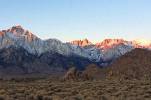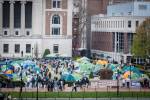Nevada needs more clean-energy leaders
We recently survived the hottest June on record in Las Vegas. My car’s thermometer, which has always been fairly accurate, registered an outside temperature of 121 degrees as I drove across town one day. It remained there for several miles before it slowly dropped down, barely into the one-teens. It was still only June! I’ve been writing about the likely effects of climate change for years but the reality of the experience is deeply disconcerting.
We need to get a handle on this issue and most of my columns focus on things we can do as homeowners to make a difference. I know that many of you share my concern and have taken steps to live lighter on the planet by reducing energy consumption and installing solar energy systems on your homes. I applaud your efforts.
While we do our part in the community, others are working in parallel to move things forward on the national and international stages. Thanks to the leadership of Sen. Harry Reid, Las Vegas will again host the annual National Clean Energy Summit. This will be version 6.0 and is titled “Energizing Tomorrow.” Reid brought the first summit to Las Vegas in 2008. Since then, our state has made major progress in the clean-energy sector with ripple effects across the nation.
Nevada is on track to shut down its remaining coal-fired power plants for good. Our state is becoming a clean-energy leader with large utility-scale projects gaining momentum along with rooftop solar . Mandalay Bay recently announced the planned installation of one of the largest rooftop solar photovoltaic arrays in the world at its convention center . It will generate enough electricity to power the equivalent of 1,000 homes.
On a national scale, the installed capacity of photovoltaic solar-energy systems in 2012 was 80 percent higher than in 2011 and the utility-sector rate more than doubled. The annual capacity growth rate for photovoltaic capacity has exceeded 40 percent for six straight years. It is no coincidence that the sixth National Clean Energy Summit will take place next month. These summits are helping to improve our world and if you want to be at the forefront of the clean-energy transformation that is sweeping the globe, there is no better opportunity.
You can join the thought-leaders on the cutting edge of clean-energy policy, manufacturing and implementation Aug. 13 at the Mandalay Bay. Visit www.cleanenergyprojectnv.org to learn more and to register for this year’s summit.
The broad range of speakers includes Interior Secretary Sally Jewell and Energy SecretaryErnest Moniz.
Panel discussions will feature policymakers and industry leaders presenting ideas and options for the estimated $2 trillion global clean-energy market. The panel topics this year include “Clean Energy Solutions in States,” “Breaking Through Gridlock on Energy Policy,” “21st Century Energy Market,” “From Innovation to Deployment” and “Resilience to Extreme Weather.”
That last topic will explore how clean energy and investment in our critical infrastructure can make communities more resilient to the growing incidence of extreme weather. I can’t think of a better idea than building greater resilience into our communities. We made it through June, but the ride ahead may be much more challenging. Perhaps the National Clean Energy Summit will provide the vision to help you become a clean-energy leader, too. Don’t be shy, the world needs you.
Steve Rypka is a green living consultant and president of GreenDream Enterprises, a company committed to helping people live lighter on the planet. For more information and links to additional resources relating to this column, or to reach Rypka, visit www.greendream.biz.























